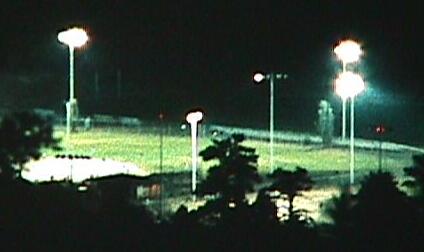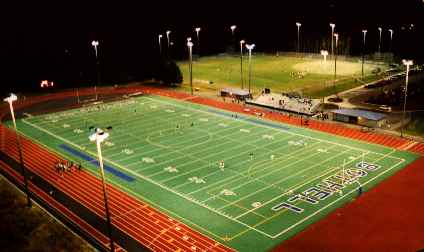

Lighting levels used for night sports are the highest commonly encountered in the nighttime environment. Recommended levels for social or recreational sports, including most municipal sports activities, range from 200 to 500 lux (20 to 50 footcandles); levels for professional play with large spectator attendance and television coverage can reach 3000 lux (300 footcandles). Controlling trespass and glare with such lighting levels is an extreme technical challenge, requiring the utmost in quality luminaires and design.
Further, the lighting fixtures commonly used for sportsLighting can be huge sources of direct glare, not only to areas nearby and at considerable distances from the sports fields, but also to spectators and players actually using the fields. The brightest single sources of light visible in city nighttime landscape views are often these facilities. It is no surprise that such lighting is usually the single greatest source of complaint and neighborhood tension about lighting issues.
 |
|
|
 |
|
|
In the past, available fixtures, lighting designs, and the general level of the sports lighting art often left little choice for communities and designers seeking to minimize spill and glare in sports lighting. Even today, some manufacturers and designers will claim that spill and uplight cannot be reduced much below those obtained with these older designs and fixtures. Fortunately, several manufacturers have begun producing well shielded, even fully shielded luminaires suitable for sports lighting, particularly for the most commonly encountered levels of lighting. These designs provide major reductions in off-field spill, and can entirely eliminate direct uplight in all but the brightest lighting levels required for professional level sports. Further, many feel that these designs deliver substantially improved lighting quality on the field for the players.
Unfortunately, many facilities, particularly older ones, will continue to produce enormous amounts of light spill into adjacent areas, and both direct and reflected light into the sky. With quality designs using modern fixtures, these obtrusive effects can be considerably reduced, but the huge amounts of lighting required in some situations will always lead to some obtrusive impacts, even with the best design. Communities should be aware of the potential impacts. The location and alignment of new fields should be carefully considered. Technical specifications for sports lighting can be included in a lighting code that require fully shielded lighting where at all possible, and professional design and post-installation certification to assure that the standards are followed.
Soft™ Lighting Systems, Inc. web page: http://www.serv.net/~softlite//index.html
Soft™ Lighting Systems, Inc. list of representatives:
Lighting Group Northwest, Inc. Western Washington
P. O. Box 80585 Phone: 206.763.22573
Seattle, WA 98108-0585 Fax: 206.763.2764
Web Site: http://www.lightinggroupnw.com
Main Contact: Ken Freed kfreed@lightinggroupnw.com
Nevada Lighting Representative
4690 Longley Lane Phone: 775.329.3411
Suite #1 Fax: 775.329.4290
Reno, NV 89502-7935
Main Contact: Patrick O'Flaherty
poflaherty.nvlighting@lighting.net
CRI Lighting Sales, Inc. Southern California
7933 Silverton Avenue Phone: 858.695.8300
Suite #715 Fax: 858.695.0303
San Diego, CA 92126-6352
Main Contact: Tom Valley tomvalley@crilighting.com
Watkins Sales Company, Inc. Arizona
P. O. Box 32010 Phone: 602.244.9815
Phoenix, AZ 85064 Fax: 602.220.0430
Main Contact: Dennis Watkins watkinssalesco@aol.com
Web Site: http://www.serv.net/~softlite//index.html